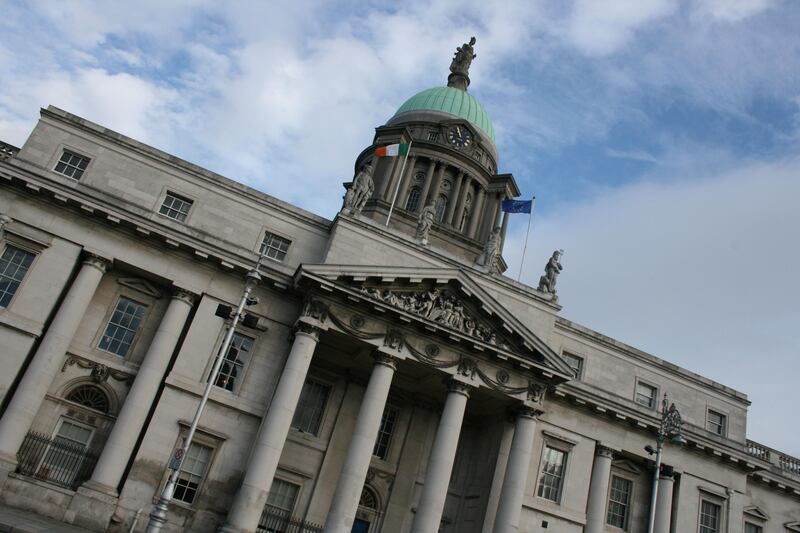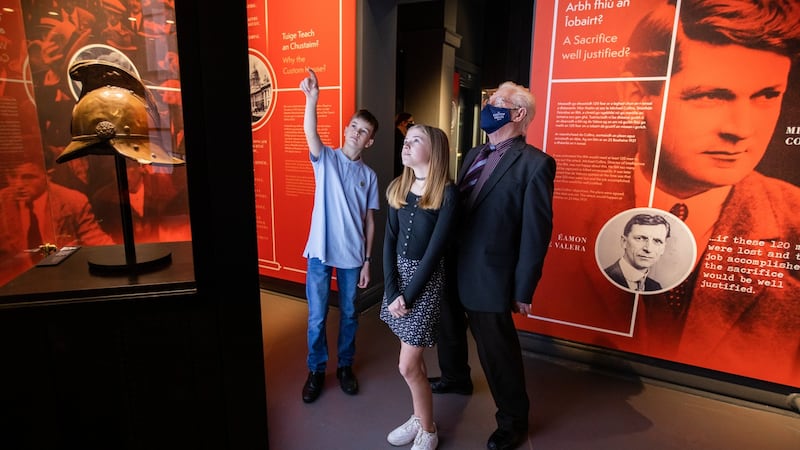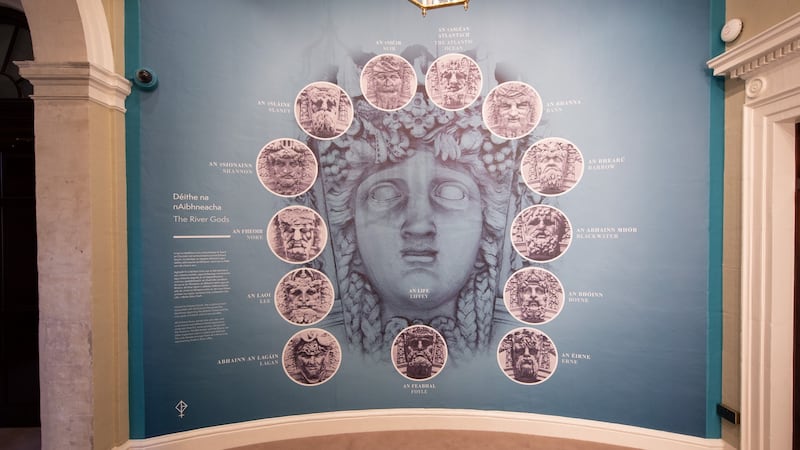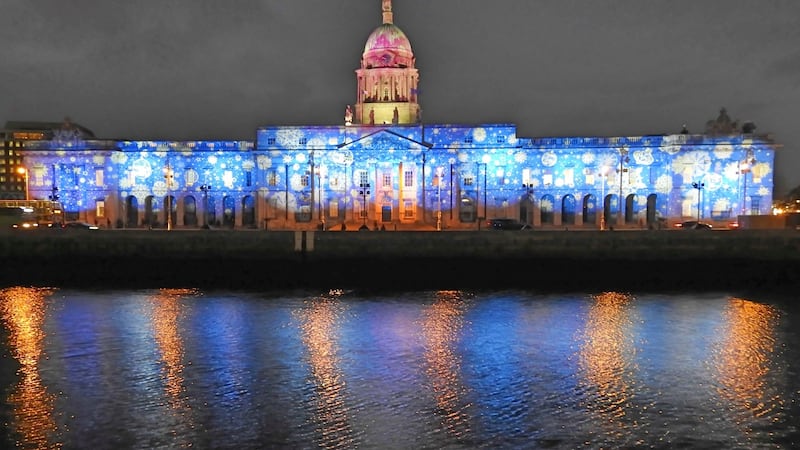Fascinating as their contents may be, museums are often just as interesting as an excuse to explore intriguing buildings. For every visitor to the exhibitions at the Guggenheim Bilbao, there are more who have simply come to gawp at the innards of Frank Gehry’s wriggly building. So, unless you have previously joined one of the Irish Architecture Foundation’s Open House tours, or have pressing business at the Department of Housing, Local Government and Heritage, lovers of enthralling edifices will be delighted to know that the new(ish) Visitor Centre at the Custom House is ready to welcome you.
I say new(ish) because the centre actually opened in November of last year, in time for the centenary of the building’s famous burning, and the 230th anniversary of the day its doors first opened as a palace of taxation and commerce. But, as we all know, our minds were somewhat distracted last winter, and so it’s a good time to explore James Gandon’s celebrated construction, which has been described variously and regularly as a jewel in Dublin’s architectural crown, a masterpiece of neo-classicism, and as the most important building in Dublin.
Despite these accolades, the Custom House has more recently pulled off the interesting feat of being hugely visible, and yet largely ignored. Unlike the GPO, it does not occupy a romantic space in the Irish imagination. While popular myth making would put the numbers of occupants of the Post Office in 1916 in their thousands, the Custom House didn't really figure at all – except as a British Army stronghold, and a prison for holding captured rebels.

In fact, our relationship to the building has been so ambivalent that after its burning, and following the foundation of the new Irish Free State, there was considerable debate about whether to rebuild it at all. Estimates were put at £1.1 million (about €70 million today). Some suggested it should be the new GPO, others a train station, and yet more a public park. It took four years, but eventually the OPW's principal architect, Thomas Joseph Byrne, worked out that both it and the GPO should be rebuilt.
Saving money, Byrne repurposed about 230,000 of the original bricks, ditched the great hall, and used Irish limestone and granite, instead of Portland stone, for the central tower under the building’s dome. This means the tower is of a different colour, which has been controversial in some quarters, but seems to me to acknowledge the layers of time and history the building now embodies. That difference also underpins the conflicted relationship we have tended to have in this country with architecture from the colonial period.
One of the excellent information panels in the Visitor Centre quotes an anonymous description, dating from 1796, of Dublin’s Georgian buildings as “the gorgeous mask of Ireland’s distress”. The scent of those sentiments lingers.


Writing on the Custom House in his recent book, The Dignity of Everyday Life, which explores near neighbour Busáras, Eoin Ó Broin suggests that “Gandon’s Custom House represents a very particular moment in Ireland’s history. Its neoclassical style exudes the pomp and grandeur of empire. Its function placed it at the epicentre of the imperial mercantile economy. It is a building depicting Ireland as part of, indeed subject to, the British Empire.”
It is, and it isn’t. Every country and culture’s history includes stories and layers of times sooner forgotten. Buildings can be an emblem of that, and yet it’s what we do with those stories that defines and builds our present – and future. The Custom House fire of 1922 burned for five days, reaching temperatures of 1,300 degrees Fahrenheit. Even after the fire had been extinguished, it took weeks for the interior to have cooled sufficiently for the damage to be fully assessed.
The burning, while highly symbolic, destroyed what the New York Times accurately described at the time as 'priceless records'
“We in common with the rest of the nation regret the destruction of historical buildings,” went the statement in the Irish Bulletin, the Irish Republican gazette. “But the lives of four million people are a more cherished charge than any architectural masterpiece. The Custom House was the seat of an alien tyranny.”
Within that seat of tyranny were housed local government records, some dating back to the 1600s. Most were reduced to ashes by the intense heat. The burning, while highly symbolic, destroyed what the New York Times accurately described at the time as “priceless records”, creating huge gaps in our understanding of the minutiae of lives and families over centuries.
Going back to its commissioning in 1781, the Custom House took 10 years to build, at a cost of £200,000. On its façades, Edward Smyth was tasked with creating representations of Ireland's rivers. Smyth, who Gandon described as having talents "equal to Michelangelo", carved 14 faces. There are 13 river gods, and one face for the Atlantic Ocean.
Apart from Anna Livia, representing the Liffey, all are men demonstrating a range of moods. The Barrow is decidedly downhearted, while the Bann is positively cheery. It is speculated that Smyth made them men because he had so much fun with the beards.
The new Visitor Centre is a mine of such information, laid out in panels, interactive displays and with accompanying video and photography. The guides are also well informed and keen to help. On my visit, Colm Jackson and visitor team experience manager Pauline Kennedy have an infectious love for the building and the stories contained within its walls.

A partnership between the OPW, Fáilte Ireland and the Department of Housing, Local Government and Heritage, the exhibition itself leans on the skills of an advisory panel made up of Diarmaid Ferriter, Liz Gillis, Lar Joye, Conor Lucy and Ellen Rowley.
Their collective knowledge on display encompasses everything from the story of the building and its craftspeople to the ins and outs of goods entering and leaving the city by ship at a time when the seas were often less dangerous than travel by land. Through this latter, we also discover an expanding Dublin in which there were a thousand licensed beggars, and about 100 breweries, distilleries and refineries. This was a Dublin of increasing inequalities, leading to violence and rumblings of unrest.
From here, we go to the Rising and War of Independence, to the burning and eventual rebuilding. These threads are explored from the perspectives of both sides, and it's a lot to take in; so much so that some of the more recently famous former staff at the Custom House, including Percy French and Brian O'Nolan, aka Myles na gCopaleen, aka Flann O'Brien barely find room for more than a brief mention. Percy French was an inspector of drains, when not delighting as an entertainer, and both he and O'Nolan worked for the Department of Local Government, which has been based in the building (apart from the obvious hiatus of its utter destruction) in its various incarnations since the late 1800s.
Today, the department also encompasses heritage, which includes the intriguingly titled Underwater Archaeology Unit.

Entering from the north side of the building, there is a grand staircase, and a 1950s style to some of the interior panelling, which carries lovely echoes of Busáras, in view across the road. Currently accessible only to those on legitimate business, there is talk of exploring more ways to open up the building as a whole – balanced of course with the needs of those engaged with housing, planning, building standards, electoral supervision, Met Éireann, monuments, underwater archaeology and the like. In the meantime, you have the whole riverside of the building to explore.
This isn't the first time there has been a Visitor Centre at the Custom House; there had been a version in the 1980s. Later, an exhibition on a smaller scale was opened in 2016 on the centenary of the Rising. At that time, it was scheduled to run for less than a month, although, as Olivia Kelly reported in this newspaper at the time, the Department of the Environment had said it "could be extended if there is sufficient interest". Today, the exhibitions, the building that houses them, and the stories they both have to tell are indeed more than sufficiently interesting. Go, see.










